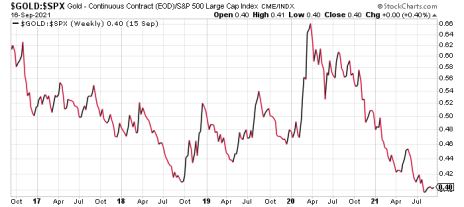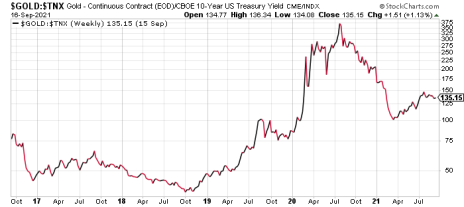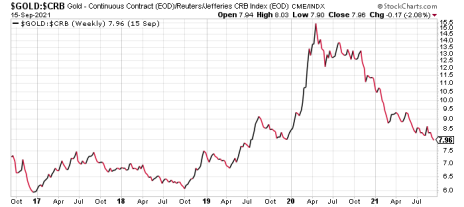Owning gold is a great way to diversify your portfolio while also insuring against an uncertain economic outlook. But as with all investments, known when to buy is important and can mean the difference between profits and being stuck with an underperforming asset. With that in mind, here are five questions that I believe every prospective investor should ask before taking the leap and buying gold.
Buying Gold Question #5: Is Gold Outperforming the S&P 500?
It’s not always necessary that the metal should outperform the S&P 500 Index (SPX) before buying gold. In fact, in the majority of cases stocks will outperform gold, even when both assets are in simultaneous bull markets.
But whenever gold is clearly outperforming stocks from a relative strength standpoint, it’s a sign that gold likely has a strong psychological backdrop (i.e. fear-driven purchases), and has also generated a tremendous amount of forward price momentum which can be self-sustaining for an extended period.
Moreover, it’s not normal for gold to outperform stocks, so when it does happen it’s a clear sign that owning gold is a good idea. Whenever this has happened in recent years (most recently from late-2018 to mid-2020), buying gold was the correct strategy from an investment perspective.
Buying Gold Question #4: Is Gold Outperforming the 10-Year Treasury Yield?
Longer-dated U.S. Treasury bonds compete with gold, and since gold offers no yield, whenever the 10-year Treasury Yield Index (TNX) is trending higher, it usually means gold will suffer since investors will naturally be drawn to higher-yielding bonds.
But when gold is outperforming the 10-year Treasury yield index, it’s usually a good idea to own gold since a.) lower bond yields offer no competitive threat to gold, and b.) higher gold prices and lower yields also implies that investors are worried about the growth outlook. And anytime investors have serious misgivings about the economy is normally a good time to start buying gold (as in 2019 and 2020).
Buying Gold Question #3: Are Platinum and Palladium Leading Gold?
It’s not uncommon for the white metals, platinum and palladium (particularly the latter), to lead gold prices higher for several weeks after there has been a major decline in precious metals prices across the board.
Because they’re both widely used in industrial applications as well as used for investment purposes, platinum and palladium tend to top and bottom before gold. For instance, when gold and the other metals have been running higher for several months, then platinum and palladium turn lower while gold is still rising, it’s a near-certainty that gold will soon follow the white metals lower.
Conversely, after a major decline, when both platinum and palladium began moving higher while gold is still edging lower, or sideways, it’s usually a good bet that gold will eventually follow the white metals higher.
One prominent example of this would be platinum and palladium (especially the latter) topping out several weeks before gold during the summer of 2011—a fateful year in which gold posted a multi-year peak after an historic bull run in the previous years.
Platinum—and particularly palladium (see chart below)—also both confirmed that a powerful new bull market was beginning in the late summer and early fall of 2018 a few weeks before gold’s bull market got underway.

The bottom line is that it usually pays off to pay attention to what platinum and palladium are doing before buying gold.
Buying Gold Question #2: Is Silver Leading (or At Least Keeping Pace With) Gold?
Silver has long been regarded as gold’s “sister” metal, and while the two metals don’t always trade in lock-step, they do tend to move in the same general direction for extended periods. Moreover, divergences between gold and silver prices are uncommon and should never be ignored if it happens.
Ideally, silver should lead gold—or at least slightly outperform it—in the early stages of a precious metals bull market. The rationale behind this is that silver is lower priced than gold (often referred to as the “poor man’s gold”); thus, whenever informed investors believe gold is about to take off, they’ll be tempted to leverage the coming bull market by loading up on cheaper silver. This often causes silver to begin rallying before gold does, and can therefore be taken as a tell-tale sign that the “smart money” is probably bullish on gold.
By the same token, if gold starts to rally and silver refuses to join the party, it should be viewed as a bearish omen for gold. For without the participation of silver, rising gold prices usually don’t last very long since a truly bullish environment for gold will always sooner or later attract speculative interest in silver. A failure to do so likely means that gold’s rally is simply a temporary short-covering affair or else a “head fake” based on ephemeral technical factors and not on solid fundamental reasons.
Buying Gold Question #1: Is Gold Outperforming the CRB Commodity Index?
This particular question might seem counterintuitive at first glance. After all, since gold is itself a commodity, why would it matter if the yellow metal is outperforming other commodities? And if commodity prices are broadly trending higher, isn’t that generally good news for gold?
The answer to the latter question is, “not necessarily!” Many investors erroneously assume that gold is mainly driven higher by inflation. But there have been many times when gold has actually underperformed relative to other commodities during periods of mild inflation. It’s not so much inflation that drives gold higher, but fear.
Gold’s “fear factor” is the number one catalyst for higher bullion prices. When the economy and the geopolitical outlook are positive, investors tend not to worry and thus are less likely to purchase safe-haven assets like gold and instead focus on risk assets like equities.
During times when commodities like the “energies” (such as oil, gasoline and natural gas), the “ags” (e.g. corn, soybeans and wheat) and “softs” (like coffee, cocoa and sugar) are on the rise, it’s usually because commodity traders expect an accommodative central bank and/or fiscal policy to benefit inflation-sensitive hard assets.
What’s more, when these types of commodities rally, it tends to fuel speculative fervor on the part of traders in search of quick profits. Again, during such times gold is typically shunned because investors are being driven by greed, not by fear. One of the best ways to see the dominant trend of the above-mentioned commodities is to use the benchmark Reuters/Jefferies CRB Index (CRB). The CRB combines several key commodities in each of the major hard asset categories to provide an aggregate price index for natural resource prices.
When gold is outperforming the CRB, in most cases it can be assumed that fear is the dominant emotion among traders, who are shunning other commodities in exchange for the peace of mind that gold typically brings in uncertain times. Recent examples of this include the period between late 2018 and mid-2020, when a combination of fears relating to the U.S.-China trade war, inverted yield curve and Covid-19 crisis caused participants to turn to the safety of the yellow metal.
In conclusion, if you can answer “yes” to three of these five questions, then owning at least some gold might not be a bad idea. If you can answer “yes” for four of the five questions, you should probably have some exposure to the metal. And if there’s a “yes” answer to all five then you would be justified in aggressively buying gold.
However, if you can answer affirmatively to only one or two of these questions then you should probably hold off on buying gold and wait for a better entry point.
For more insight into gold and precious metals investing subscribe to Sector Xpress Gold & Metals Advisor today!
Is gold’s value as an inflation hedge or as a portfolio diversifier more important to you?



